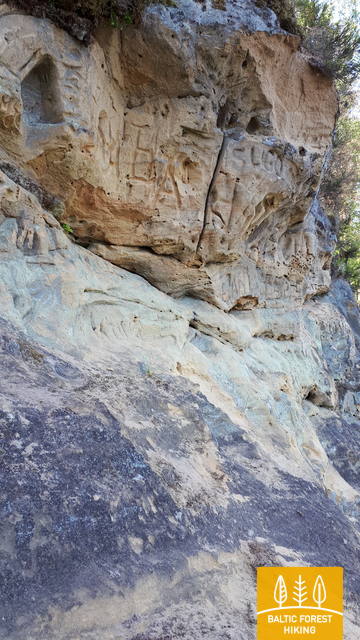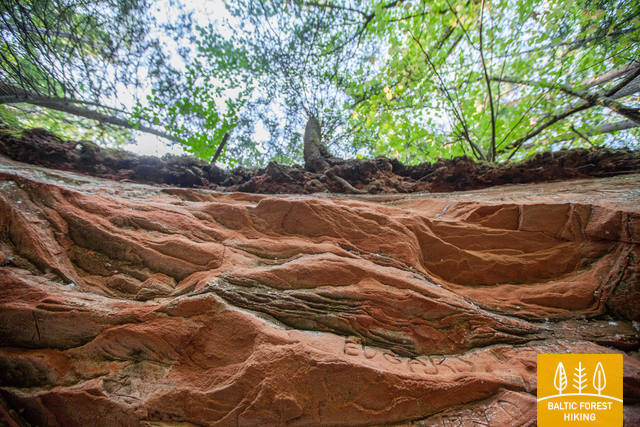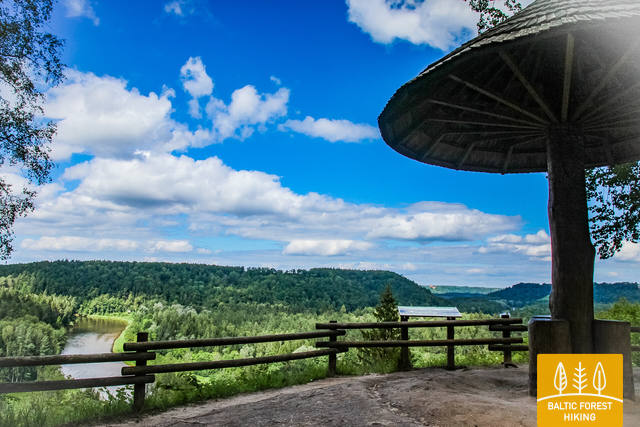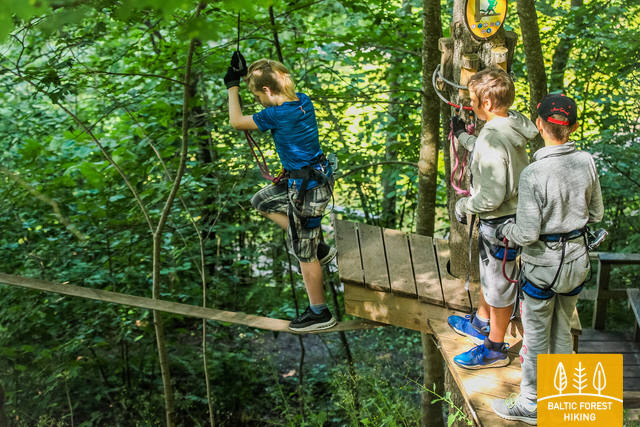Atkarpa 4. Rāmkalni - Sigulda.
 Verta pamatyti
Verta pamatyti

|
~15 m deep sandstone cave. |

|
Murjāņi, tel: +371 29100280, +371 67977277. Also ATM. |

|
World War I bunker. |
In the village of Gauja in Riga region, various technical units tracing back to several decades ago are stored and maintained, as well as the heritage from the Latvian roads of the past, which could be interesting both for Latvian residents and foreign tourists. Learn more... Tel: +371 26884037 Email: info@gaujasklubs.lv |
|

|
The first (when hiking from Riga) and largest sandstone outcrop on the Forest Trail. |

|
A sandstone outcrop on the banks of Gauja River. |

|
Impressive sandstone cliffs, caves, and niches can be found along the shores of the ravine. Over Lorupe ravine on Vidzeme highway in 1978 a viaduct was built. |

|
The bridge was built in 1979 across the Gauja river with the aim to create a round route for the visitors of Gauja river ancient valley. The bridge offers a picturesque view to the Devil's sandstone outcrops and the Gauja. |

|
The Devils cave Rocks are the largest outcrop in the Pikene cliffs, an almost 2 km large base of the Gauja valley's mainland. The exposed rock is 250 m long and 15 m high. The Devil’s cave is located inside the rock, 8 m above the Gauja river. |

|
A viewing spot at the high Beite ravine. Gained its name after the Russian Emperor Alexander II visited Sigulda. The viewpoint offers a significant view to the Gauja river and Turaida castle. Stairs and trails will take you to the Gauja river. |

|
A viewing spot, gained its name after the Russian Emperor Alexander II visited Sigulda. The viewpoint offers a significant view to the Gauja river and Turaida castle. Stairs and trails will take you to the Gauja river. |

|
Adventure park Mežakaķis is an obstacle course in the forest. On the trees at different heights of attaching a small platform between which stretched ropes, nets, various constructions bridges, swings, logs, ropes, and ladders. |

|
Gauja ancient valley is an area located on both sides of the Gauja river. It starts at the estuary of the Abuls river (above Valmiera) and ends at Murjāņi and mostly belongs to the Gauja National Park. Near Sigulda it reaches the maximum depth - 85 m (about 1 km wide). |

|
This artificial ice track, built in 1986, was the first Bobsleigh and Luge Track in all Baltic states. The Bobsleigh and Luge Track Sigulda is one of 18 constructions of this type in the world. Track is 1420 meters long, with 16 curves and a 200 m long braking distance. |

|
The widest and highest cave or grotto in Latvia and all Baltics. It is 19 meters deep, 12 meters wide and 10 meters high. It is also the oldest tourist attraction in Latvia. |

|
Sigulda's first railway station was built in 1889 and replaced by three more stations over time. The third station was designed by architect Pēteris Feders and it was built in the style of national romanticism and was considered the most beautiful station building in Latvia. In 2012 the reconstructed Sigulda railway station, the station square and the Laima clock were opened. |

|
Siguldos pilies kvartalas yra mėgstama poilsio vieta siguldiečių ir miesto svečių bei Siguldos rajono renginių centras. Pilies kvartale yra Livonijos ordino Siguldos pilis ir Siguldos Naujoji pilis. Pilies kvartalo pastatuose dirba amatininkai ir menininkai, kurių dirbtuvėse ir salonuose galima išmokti naujų įgūdžių ir įsigyti suvenyrų bei dovanų. |











